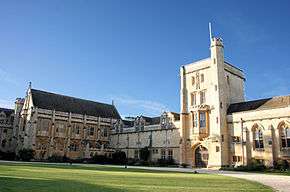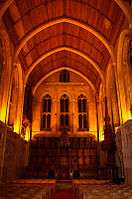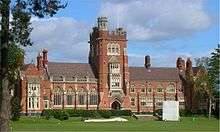Mansfield College, Oxford
| Colleges and halls of the University of Oxford | |||||||||||||
| Mansfield College | |||||||||||||
 | |||||||||||||
|
| |||||||||||||
| College name | Mansfield College | ||||||||||||
| Motto | Deus locutus est nobis in filio ("God hath spoken unto us by [his] son", Hebrews 1:1–2) | ||||||||||||
| Named after | George and Elizabeth Mansfield | ||||||||||||
| Established | 1838 as Spring Hill College 1886 as Mansfield College | ||||||||||||
| Sister college | Homerton College, Cambridge | ||||||||||||
| Principal | Baroness Kennedy | ||||||||||||
| Undergraduates | 214[1] (December 2012) | ||||||||||||
| Graduates | 102 | ||||||||||||
| Location | Mansfield Road | ||||||||||||

| |||||||||||||
| Homepage | |||||||||||||
| Boatclub | |||||||||||||
 | |||||||||||||
| Blazon | Gules an open book proper inscribed DEUS LOCUTUS EST NOBIS IN FILIO in letters sable bound argent edged and clasped or between three cross crosslets or. | ||||||||||||
Mansfield College, Oxford is one of the constituent colleges of the University of Oxford in England. As of December 2012,[1] the college comprises 214 undergraduates, 102 graduates, 36 visiting students and 58[2] fellows and academics.
History
The college was originally founded in 1838 as Spring Hill College, Birmingham, a college for Nonconformist students.[3] In the nineteenth century, although students from all religious denominations were legally entitled to attend universities, they were forbidden by statute from taking degrees unless they conformed to the Church of England.

In 1871, the Universities Tests Act abolished all religious tests for non-theological degrees at Oxford, Cambridge, London and Durham Universities.[4] For the first time the educational and social opportunities offered by Britain's premier institutions were open to all Nonconformists. The Prime Minister who enacted these reforms, William Ewart Gladstone, encouraged the creation of a Nonconformist college at Oxford.
Spring Hill College moved to Oxford in 1886 and was renamed Mansfield College after its greatest donors, George and Elizabeth Mansfield.
The magnificent Victorian buildings, designed by Basil Champneys, were completed in 1889.
Mansfield was the first Nonconformist college to open in Oxford. Initially the college accepted male students only, the first woman being admitted in 1913.
During World War II, over 40 members of staff from Government Code & Cypher School moved to the college to prepare the British codes and cyphers, whilst the GC&CS members at Bletchley Park worked to decipher the German enigma codes.[5]
In 1955, the college was granted the status of Permanent Private Hall within the University of Oxford and in 1995 a Royal Charter was awarded giving the institution full college status.
Since the college was first formally integrated into the University structure in 1955, its Nonconformist aspects have gradually diminished. Until 2007, the United Reformed Church (URC) sponsored a course at Mansfield for training ordinands. These students became fully matriculated members of the University and received degrees. Mansfield no longer trains URC ordinands.[6]
The Nonconformist history of the college is however still apparent in a few of its features. A portrait of Oliver Cromwell hangs in the Senior Common Room and portraits of the 1662 dissenters hang in the library and the corridors of the main college building, together with portraits of Viscount Saye and Sele, John Hampden, Thomas Jollie and Hugh Peters.
One place where the Nonconformist history of the institution is still very much apparent is in the college chapel. It is a non-consecrated space and contains a unique selection of stained glass windows and statues depicting leading figures from Nonconformist movements, including Cromwell, Sir Henry Vane and William Penn among many others. In 1940, whilst he was a lecturer at University College, future British Prime Minister Harold Wilson married Mary Baldwin in this chapel, although he was not a member of the college. Chapel services are still conducted in a Nonconformist tradition. Nevertheless, over the years attendance at chapel services has declined and the make-up of the general student body no longer reflects the Nonconformist religious origins of the college.
Because of its Nonconformist roots, the college still has many strong links with American schools. It has a long established tradition of accepting roughly 30 "Junior Year Abroad" students from the USA every year. These students come to study in Oxford for one academic year and have full access to its libraries and their designated tutors.
As of 2012, the college had an estimated financial endowment of £10 million.
Grounds
Location
The grounds of Mansfield College are located on Mansfield Road, near the centre of Oxford. The grounds are near the University parks and the River Cherwell. The college shares a boundary wall with Wadham College.
Buildings
The main building was designed by architect Basil Champneys, and built between 1887 and 1890. It houses the main college library, the law library and the theology library. It is also home to the college's Junior Common Room, Middle Common Room, and Senior Common Room. The main college building encloses 3 sides of the large quadrangle, which has a circular lawn. The college also has several other buildings, primarily used for student accommodation, which are opposite the main building.
The college is currently expanding student facilities and raising funds for a new building on the college grounds. The new Love Lane Building will incorporate 74 en-suite study bedrooms, seminar rooms and a 160-seat auditorium that will be used for lectures, as a cinema, moot court and performing arts space.[7]
Love Lane has been designed by Rick Mather Architects. When given planning permission, the City Planning Department praised the building for its use of renewable energy sources.[8]
Academic performance
Mansfield ranked 12th out of 30 in the 2011 Norrington Table,[9] after being 23rd in 2008[10] 28th in 2009[11] and 29th in 2010.[12] "[S]ince the number of degrees awarded per college are small, these rankings should be treated with caution."[13] Mansfield's academic performance, as reflected in the Norrington Table, is currently within the same 10% range as most of the other colleges.[13]
Student life
Mansfield College Boat Club and a number of other college organisations are popular amongst the students, achieving results at the level of, or competitive with, the larger colleges. Many of the sports teams are "combined" in partnership with Merton College.
As of the start of 2011, the 1st XI football team play in the JCR Premier League, the 1st XV rugby team in the JCR 3rd division and the 1st XI cricket team in the Premier Division. The netball team is currently in the 2nd division. Recently, the college has enjoyed significant sporting success: winning the 2010/11 JCR football Premier League, 2011 rugby Cuppers Bowl and achieving 4 consecutive promotions in college netball. The cricket team is also a dominant force in the JCR leagues, with numerous Cuppers and League titles in the past five years.
Like many of the constituent colleges of Oxford University, Mansfield holds a ball once every three years. The most recent ball took place on 27 February 2016, and was themed 'The Doors of Perception'.[14] The ball before that took place in Hilary 2013, and was themed 'Atlantis'. The ball prior to that took place on 7 November 2009 and was themed 'Circus of the Macabre'.
People associated with Mansfield
Academic staff and fellows
Albert Schweitzer, theologian and famous Bach expert was a special lecturer at Mansfield and often performed on the chapel organ. Rev. John Muddiman, G. B. Caird Fellow in New Testament Theology, and Michael Freeden, director of the Centre for Political Ideologies and founding editor of the Journal of Political Ideologies are two recently retired (now Emeritus) Fellows of the College. Dame Jocelyn Bell Burnell, the British astrophysicist known for first discovering radio pulsars, is currently a visiting professor.
Honorary fellows of the College include Jimmy Carter, 39th President of the USA, Shami Chakrabarti, Director of the civil rights group Liberty and Chancellor of Oxford Brookes University, Will Hutton, prominent journalist and economist, and Paddy Ashdown, diplomat and politician.
Notable alumni
- Pamela Sue Anderson, philosopher
- Chris Bryant, MP
- G. B. Caird, biblical scholar, Senior Tutor, and Principal; later Dean Ireland's Professor of Exegesis of Holy Scripture at the University of Oxford.
- Constance Coltman, one of the first women ordained to Christian ministry in Britain
- Paul Crossley, pianist
- Adam Curtis, BAFTA award winning filmmaker, producer and writer
- The Rev. Kwesi Dickson, academic, theologian, author and former President of Methodist Church Ghana
- James Dingemans, constitutional lawyer and prosecutor during the Hutton Inquiry
- C. H. Dodd, theologian, chairman of New English Bible translators
- Susan Durber, Principal of Westminster College, Cambridge
- Uri Gordon, anarchist writer and activist
- Colin Gunton, theologian
- Guy Hands, private equity investor, founder of Terra Firma Capital Partners
- Peter Hessler, US writer and journalist
- Charles Silvester Horne, MP, Nonconformist author, hymn writer and preacher
- Lincoln Hurst, biblical scholar and film historian
- Philip Andrew Jones, Royal Navy Officer, an Admiral, First Sea Lord - Head of the Royal Navy.
- R. Tudur Jones, Welsh nationalist and theologian
- Donald MacDonald, President of Oxford University Boat Club in the mutiny year of 1987, recorded in the book True Blue: The Oxford Boat Race Mutiny
- Michael Pollan, US author, journalist and activist
- Stephen Pollard, British author and journalist
- The Rev. Cecil Pugh, GC, Royal Air Force chaplain and George Cross recipient
- The Rev. H. Wheeler Robinson, Principal of Regent's Park College, Oxford and Old Testament scholar
- The Rev. Erik Routley, composer and musicologist
- Justin Rowlatt TV journalist
- Adam von Trott, member of the German resistance in World War II[15]
- Amos Wilder, US poet and theologian
- Marcus Borg, US academic and theologian
Staff
The retired porter Hugh Flint was the drummer for John Mayall & the Bluesbreakers and appeared on their first two albums, the second of which featured Eric Clapton. He later formed the band McGuinness Flint.
College grace
In 2011, Mansfield College adopted two distinct pre-supper graces, one religious and one non-religious, in an effort to be inclusive to persons of different faiths, or none.[16]
- Benedictus Benedicat
May the Blessed One Bless
- Nullius boni possessio est iucunda sine socio
No good thing is worth having unless you have someone to share it with.
Prior to 2011, the college used the following, specifically Christian grace, adopted in 1953:[17]
Omnipotens Deus, clementissime Pater, omnis boni fons, in donis tuis gaudentes nomen tuum magnificamus, per Jesum Christum Dominum nostrum. Almighty God, Father of mercies and fount of every good, in the enjoyment of thy gifts we bless thy name, through Jesus Christ our Lord.
Gallery
 Interior of the Chapel
Interior of the Chapel View of the Chapel from the Quad, just outside the main building.
View of the Chapel from the Quad, just outside the main building. View of the Principal's Lodgings from the American Institute.
View of the Principal's Lodgings from the American Institute. Previous site of the college (Spring Hill College, now Moseley School)
Previous site of the college (Spring Hill College, now Moseley School)
References
- 1 2 "Students by college/permanent private hall". University of Oxford.
- ↑ "Fellows and Academics". Mansfield College, Oxford.
- ↑ "Mansfield College Historical Background".
- ↑ "Universities Tests Act 1871 s.3".
- ↑ http://www.bletchleypark.org.uk/content/hist/wartime/diaries/august1939.rhtm
- ↑ "The last URC minister to qualify through Mansfield College".
- ↑ https://www.mansfield.ox.ac.uk/fileadmin/Documents/Love_Lane_Brochure.pdf
- ↑ http://www.mansfield.ox.ac.uk/alumni/love-lane-campaign.html
- ↑ Oxford University Undergraduate Degree Classifications 2010/11
- ↑ "2007 Norrington Table".
- ↑ "2008 Norrington Table".
- ↑ Oxford University Undergraduate Degree Classifications 2009/10
- 1 2 Ibid
- ↑ www.mansfieldball2016.co.uk
- ↑ "Adam von Trott Memorial Lecture at the Ambassador's Residence". 4 May 2007.
- ↑ Mansfield College Association AGM 2011 Minutes, §12, http://www.mansfieldassociation.org.uk/111118-Minutes%20of%202011%20AGM-%7BV2%7D.pdf
- ↑ Reginald Adams (1992) The College Graces of Oxford and Cambridge. Oxford: Perpetua Press ISBN 1-870882-06-7
External links
- Official website
- Website of the Junior Common Room
- Website of the Middle Common Room
- Virtual Tour of Mansfield College
